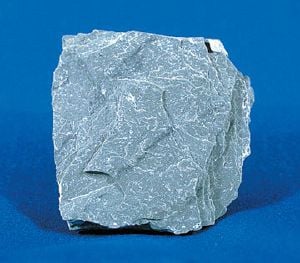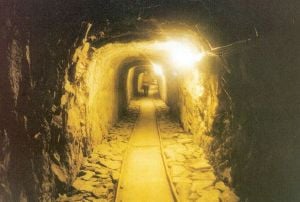Slate
- For other uses, see Slate (disambiguation).
Slate is a fine-grained, homogeneous, metamorphic rock derived from an original shale-type sedimentary rock composed of clay or volcanic ash through low grade regional metamorphism. The result is a foliated rock in which the foliation may not correspond to the original sedimentary layering.
Chemical composition
Slate is mainly composed of quartz and muscovite or illite, often along with biotite, chlorite, hematite, and pyrite along with, less frequently, apatite, graphite, kaolin, magnetite, tourmaline, or zircon as well as feldspar. Occasionally, as in the purple slates of North Wales, ferrous reduction spheres form around iron nucelei, leaving a light green spotted texture - the spheres sometimes deformed by a subsequent applied stress field to ovoids, which appear as ellipses when viewed on a cleavage plane of the specimen.
Uses of slate
Slate can be made into roofing slates, also called roofing shingles, because it has two lines of breakability: cleavage and grain. This makes it possible to split slate into thin sheets. Fine slate can also be used as a whetstone to hone knives. Due to its thermal stability and chemical inertness, slate has been used for laboratory bench tops and for billiard table tops. In 18th and 19th century schools, slate was extensively used for blackboards and individual writing slates for which slate pencils were used.
Slate tiles are often used for interior and exterior flooring or wall cladding. Tiles are installed and set on mortar and grouted along the edges. Chemical sealants are often used on tiles to improve durability and appearance, increase stain resistance, reduce efflorence, and increase or reduce surface smoothness. Tiles are often sold gauged, meaning that the back surface is ground for ease of installation.
Slate is often used as a decor in freshwater aquariums. Slate will not alter the chemistry of water {except in the slate containing feldspar which may leech silicates into the water resulting in excess diatom growth in marine aquaria). When broken, slate produces a natural appearance while remaining relatively flat and can be easily stacked. Silicon glue adheres to slate, creating a non-toxic bond to secure it. It is also used in stairs and pathways for the same reasons.
Traditional Go equipment uses slate for the black pieces.
Slate extraction
Slate-producing regions include Cornwall (famously the town of Delabole) and Wales in the United Kingdom (see slate industry in Wales), Liguria in northern Italy especially between the town of Lavagna (which means chalkboard in italian) and Fontanabuona valley, Portugal especially around Valongo in the north of the country, Germany (Moselle River-region, Hunsrück, Eifel, Westerwald, Thuringia, north-Bavaria), Alta, Norway, Galicia, Brazil around Papagaio in Minas Gerais, the east coast of Newfoundland, the Slate Belt of Eastern Pennsylvania, and the Slate Valley of Vermont and New York. Granville, New York, of the Slate Valley claims to be the colored slate capital of the world.
Slate is also found in the Arctic and was used by the Inuit to make the blades for ulus. China has vast slate deposits; in recent years its export of finished and unfinished slate has increased.
See also
- List of rocks
- Skiddaw Slate
- Tile
- Welsh Slate Museum
- Exhibition slate mine fell
- Slate industry in Wales
External links
- History of the Welsh slate industry
- Slatesite — bilingual site focusing on Welsh slate
- Step-by-step guide to how Roofing Slate is produced at Greenstone Slate
- John T F Turner - A Familiar Description of the Old Delabole Slate Quarries, 1864
cy:Llechfaen da:Skifer de:Schiefer et:Kilt eo:Ardezo fr:Ardoise it:Ardesia ja:粘板岩 nl:Leisteen no:Skifer pl:Łupek pt:Ardósia fi:Saviliuske sv:Skiffer



